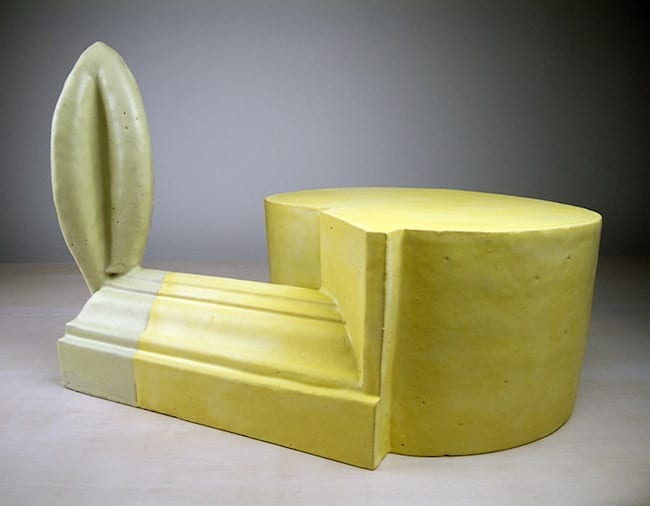The text that follows is a combination of the artist’s statement and an email discussion with CFile’s Chief Editor, Garth Clark. The exhibition took place in Baltimore at Schulman Project, a multimedia gallery with a particular affection for ceramics (February 21 – March 30, 2014 ).
The exhibition title Just at Bare Reserve comes from some word play that has its genesis in Google searches for the names of exclusive gated communities in the U.S. I am fascinated by how absurd the names of these self-enclosed suburban utopias often are and so I decided to start from there in this case. So a place name like “Bear Lake Reserve” is then stripped of its geography, its “place,” and a word changed to suggest abstraction as a kind of loss, hence “Bare Reserve.”
The final addition to make the full title Just at Bare Reserve is a play on how a town will often add something to its name in order to make it sound more important (and to escalate real estate values), so a place might be called “Stevensville” and suddenly the rich part of town splits off and calls itself “Stevensville by the Sea.”
I thought the addition of “Just at” did the same thing but in a kind of inversion. So hence, “Just at Bare Reserve.” A bit more information perhaps than you have asked for, but perhaps some insight into the thinking. Many of the titles for the ceramic sculptures actually come from some little turn of phrase from Pastoral theory, Schiller, Empson, Williams.
Just at Bare Reserve utilizes a number of different research interests that have driven my work, all of the work engaging with architecture in some way. Through architectural and design references my work revolves around issues of ornament and design as signifiers of our cultural history. Often tracing the circuitous route of modernism and its split-level by products, the work moves between the promise of decorative home goods, to re-articulations of classical motifs within suburban architectural ornament.
Formally these works present themselves as models or studies that attempt to connect abstractly our desire to establish order. The work positions itself between the known (ie. forms that have become some what prosaic; bits of colonial trim, bits of familiar suburban ornament) with an abstracted unknown, pulled from the most basic and classical architectural gestures: an arch, an opening.
I am interested in the way some pieces behave as models but also obfuscate that view by introducing the suburban ornamentation that is scaled as it is in our experience of the everyday. My hope is that because of this tension we might reconsider some of what has become transparent in our everyday surroundings.
Other works take the design sensibility of jersey stripes, and the desire for a work to signify nothing and rearticulate these within a familiar and “low” material. VCT (Vinyl Composition Tile) tile, most associated with suburban kitchens in the 1950’s and the institutional flooring of today, is a material that was originally designed to make a high aesthetic (ceramic tile, granite or marble tile) available to the masses. It is essentially a populist material and I am interested in using it for its formal qualities as well as its cultural associations.
Combining materials and formal conventions that spring historically from an American exuberance (color field painting and domestic interiors), these pieces play with simple inversions (putting the floor on the wall) and operate as backdrops or snapshots of a hybrid interior.
In terms of the molding, yes it is a reference to architecture and “style” as it relates to class, another interest of mine specifically in an “American Style.” It is a strange hybrid of the colonial and the neo-classical that we often now don’t even notice it. It combines the vernacular with the authoritarian. Many of these ideas underpin the work, but I don’t mean to illustrate them certainly. I hope they inform the pieces opaquely. In the case of this body of work, the molding elements of the work are also meant to tie the more abstract elements to the known or more prosaic details that flip the content but also the sense of scale in the work.
David S. East is the charismatic chair of the ceramics department at the Maryland Institute of Art, Baltimore.
Above image: David S. East, Myth Functioning as Memory, 2014, ceramic, 15.5″H x 22″W x 15″D

David S. East, Degrees of Ambivalence, 2014, ceramic 5.5″H x 19.5″W x 13″D

David S. East, Something Like a Post, 2014, ceramic, rubber 11″H x 17″W x 17″D

David S. East, Cultivated an Opening, 2014, ceramic 15.5″H x 15.5″W x 10″D

David S. East, Bisected Field Study, 2014, ceramic, plywood 32″H x 67″W x 10″D

David S. East, VCT_Imperial_6, 2014, vinyl composition tile, 18.5″H x 23.5″W x 3/4″D

David S. East, VCT_Imperial_4, 2014, vinyl composition tile, 24″H x 46″W x 3/4″D

David S. East, VCT_Imperial_7, 2014, vinyl composition tile, 24″H x 38″W x 3/4″D

Davis S. East at his opening at Schulman Project, Baltimore, speaking to visitors.

Add your valued opinion to this post.